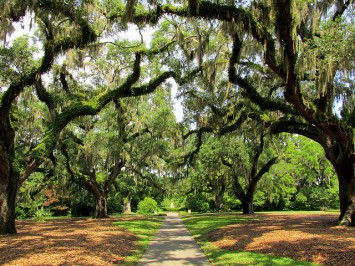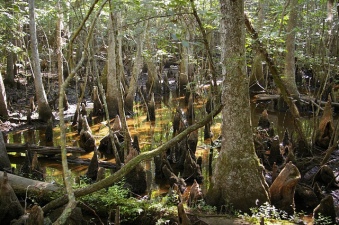 Last fall, my family took a vacation to Myrtle Beach, South Carolina, where I grew up. As a child, one of my favorite places to visit was Brookgreen Gardens, a wildlife preserve that was once the winter home of Archer and Anna Hyatt Huntington. Anna was a prominent sculptor of the early twentieth century, and decided that part of the property should be sculpture gardens open to the public.
Last fall, my family took a vacation to Myrtle Beach, South Carolina, where I grew up. As a child, one of my favorite places to visit was Brookgreen Gardens, a wildlife preserve that was once the winter home of Archer and Anna Hyatt Huntington. Anna was a prominent sculptor of the early twentieth century, and decided that part of the property should be sculpture gardens open to the public.
When they purchased the property, many of the trails were lined with live oak trees; Spanish moss still drips like thick honey off twisted and gnarled branches that drape over bricked pathways. As a child in the Low Country, live oaks always symbolized timelessness. They felt eternal and otherworldly, and my memories of visiting the Angel Oak near Charleston on school field trips – of throwing my legs over her lower branches, bark scratching up my scrawny legs – these are memories I still carry with me when I look to what was beautiful about my childhood.

And the stunning live oaks at Brookgreen Gardens? They were a favorite. Walking into the gardens last fall with my family, upon seeing Live Oak Allée I knelt down, hands pressed against ridged bark as I caught my breath. It was powerful and I was overwhelmed by the beauty. It was only later as we toured the farm areas that I learned that the live oaks were planted only a few hundred years ago, after the removal and destruction of 2000-year-old cypress forests.
Like much of the American South (indeed like the land on which the Angel Oak grows), this land had at one point been plantations, and the plantation owners had ordered the cypress forests removed, farm and paddy land cleared, and the living areas landscaped with live oaks. That enslaved Africans were forced to tear up cypress forests that had been growing for millennia (forests that at one time had been home to and were eventually stolen from indigenous people) to make way for white European economic dominance – this could serve as the impetus for its own critical assessment. Learning this sickened me while we were on our walking tour, and brought about the kind of grief born out of the flawed and horrific histories we’ve inherited.
Less important in the greater scheme of injustice but still pinching my heart was the realization that my trees – my breathtaking, “natural,” inspiring live oaks – weren’t part of the ancient beauty of this stunning landscape, but rather were substitutes for that ancient beauty, stand-ins chosen for their aesthetic splendor after the complete destruction of what had been. As someone whose path is at least partly Pagan, this provided a parallel for some of my own experiences within the Pagan and Goddess spirituality movements.

My introduction to nature-based religions came from the local metaphysical shop when I was in high school, and my early education came from pop-witchy books offering new ways of viewing the world and our relationship to it. I devoured texts and began a simple solitary path, and over the next few years of on-and-off practice, I fell in love with specific elements and archetypes, but mostly the deep respect for the earth and the feminine divine. Many of these early sources billed themselves as offering authentic “Celtic” spirituality or presented their teachings as “ancient.”
Years of study later, I came to a similar realization I’d had about my live oaks. Much of what I’d thought to be ancient and deeply historical was modern or recent tradition – some of it inspired by medieval lore or the lush spirit of inquiry of the nineteenth century, but not ancient. Much of what had been presented as Celtic had no basis in Celtic cultures, literature, or history.
This challenge has not resolved itself entirely in the years since, though I’ve consciously worked to find historically sound and culturally sensitive sources for Pagan theory and practice. Even among scholars and clergy whose work I respect, there are different standards of evidence for different aspects of our traditions, and different ways we use language to describe our beliefs and experiences.
I feel uncomfortable among live oak traditions that present themselves as the cypress forest, even when I find the live oaks stunning. I understand that modern Neopagans weren’t, themselves, the ones who chose to disrupt, uproot, and destroy ancient traditions, and I have immense respect for those who work tirelessly, seek gnosis, and scour what evidence we have – flawed and imperialist though some of it is – for clues about what mysteries those cypress forests might have held. Like the work of excavating women’s lore out from underneath the massive weight of patriarchal history, the work of uncovering Pagan Europe’s ancient traditions requires looking closely at the spaces between what is written and re-interpreting dominant and frequently dismissive narratives under the guidance of our own research and insight.

This generative function does not make live oak traditions less meaningful as models of spiritual growth and religious community. The most vibrant religious traditions have been adaptable, imaginative, and creatively brilliant in their appeal to human appreciation of mystery. They change and grow, and even had the cypress traditions survived destruction, they might have evolved into something largely unlike what they were in their pre-Christian expressions. As someone who is not affiliated with any one path, reconstructionist or otherwise, my goal isn’t abandoning our inspired gnosis (personal and shared). It’s learning to embrace and honor it even if it isn’t authentically ancient or historically verified, as long as it resonates with what I experience as real, just, and compassionate.
I no longer feel pressured to preserve an unsupported claim to ancient historicity our teachings don’t possess in order to present them as meaningful. I also no longer dismiss inspired modern teachings simply because they aren’t explicitly supported by historical evidence. I want to be clear, however, about what I’m practicing when I do it, for the sake of my own integrity and authenticity. I’ll continue to love the graceful beauty of live oaks, even as I mourn the loss of the cypress forests and seek their remnants, insights, and wisdom.
Also see: Can Good Theology Change the World?


So sad about the cypress forests. Isn’t it interesting that so many Neo-Pagans revert to “the authority of tradition” when attempting to justify contemporary practices and beliefs. It all goes to show the strong hold of traditional mindsets even among those who think they are challenging them.
LikeLike
Yes! I feel like there’s a weight and power given to “ancient” that so many want to claim, even if it means appropriating it when it isn’t authentically there. It allows a sense of superiority over these new, “invented” movements and practices, but the truth is that all religions are, to some extent syncretic or born of a syncretic impulse, and that all religions shift to some extent over time and travel. Acknowledging that we are doing that consciously and carefully doesn’t demean what we are doing; rooting our claims in false authority derived from questionable “history” misleads and muddies the work being done by those engaged in deep, academic exploration of cultural and religious histories as part of their spiritual paths. Thank you to you for being one of the leaders in that movement to explore and excavate.
LikeLike
I’ve always been disappointed in religious paths that have somehow abandoned nature as teacher. Just looking at the beautiful photos here, there’s so much love of life and freedom of expression in that gorgeous Angel Oak.
LikeLike
Yes! It really is beautiful! I haven’t been in years, and hear that they are regularly working to remove vandalism and graffiti, which is sad. Nature is a powerful and insightful teacher.
LikeLike
Well and beautifully said. Thank you!
LikeLike
Thanks, Elizabeth!
LikeLike
What a lovely, thoughtful post, Christy. Yes, there is beauty and meaning in both, and I suppose that the either/or, all/or nothing thinking is a thoroughly patriarchal form of thought.
LikeLike
You know, while I’ve been a feminist for all of my adult life and have taken coursework in women’s studies as an undergraduate, I’m current taking my first graduate level feminist theory class. We were discussing some complex issue our first week, and one of the students finally asked, “so which is it? I mean, it’ has to be one or the other that is true, right?” The teacher acknowledged that in many cases there’s a right answer, but part of the work of feminist studies is to recognize how much of what is “true” is contextual.
For me, where I draw that line in the sand has more to do with truth-in-advertising. I’ve loved the workshops I’ve taken with leaders who have been clear that we have a body of knowledge that is based in historical sources, pointed out how those historical sources might be flawed or biased, offered their own and the prevailing scholarly methods for addressing that bias, and then gone on to offer additional practices and concepts that they readily admit to having drawn from their own personal, spiritual work. They’re clear about when they’re offering history, when they’re interpreting history, and when they’re teaching from personal or communal gnosis. In this way, I can honor each of those activities, models, and practices, but with an authentic awareness of what is historical (and what period of history it comes from) and what is modern. There is beauty in both. Thanks so much for your comment!
LikeLike
Christy, thank you so much for this beautiful post. It seems familiar to me, similar to my own spiral path of Goddess and the natural world. I don’t feel at all betrayed by what I was initially taught was “ancient tradition” because it provided exactly what I needed at that time in my life. Later, as I continued learning and doing inner work, I simply found my own spiritually eclectic path, something I often refer to as Barefoot Spirituality and blog about the many facets. I see that you are quite active in community — blessings for all that you do!
LikeLike
Darla, thank you so much for your comment. It made me consider if betrayed is a word that works for how I feel about some of what is out there that I initially studied, and I really don’t think “betrayed” works for me either. We know what we know, and we frequently find what we need when we need it. I think my experiences of frustration, when they occur, are more in the past several years of my life, as my study of indigenous European traditions has focused more on historical texts, some earlier sources, and connections with modern expressions of the cultures that inform my path. I’m less concerned with the earlier foci of my studies (except in the context of how they brought me here) than I am troubled when I consider how thoroughly and unnecessarily complicated the study of authentic cultural and religious practices has become with the additional burden of weeding out spurious histories and all the secondary and tertiary works they have, themselves, spawned.
So, I practice. I continue to weed out what seems questionable, embrace what seems solid, and dance in the space between with the rest.
LikeLike